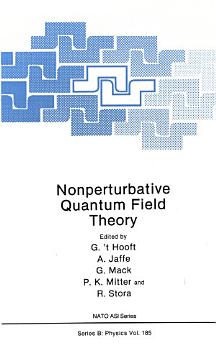Nonperturbative Quantum Field Theory
G. Hooft · A. Jaffe · G. Mack · P.K. Mitter · R. Stora
ডিচে ২০১২ · NATO Science Series B কিতাপ 185 · Springer Science & Business Media
৪.০star
২ টা পৰ্যালোচনাreport
ইবুক
603
পৃষ্ঠা
reportমূল্যাংকন আৰু পৰ্যালোচনা সত্যাপন কৰা হোৱা নাই অধিক জানক
এই ইবুকখনৰ বিষয়ে
During the past 15 years, quantum field theory and classical statistical mechanics have merged into a single field, and the need for nonperturbative methods for the description of critical phenomena in statistical mechanics as well as for problems in elementary particle physics are generally acknowledged. Such methods formed the central theme of the 1987 Cargese Advanced Study Institut. e on "Nonpert. urbat. ive Quantum Field Theory." The use of conformal symmet. ry has been of central interest in recent years, and was a main subject at. t. he ASI. Conformal invariant quantum field theory describes statistical mechanical systems exactly at a critical point, and can be analysed to a remarkable ext. ent. by group t. heoretical methods. Very strong results have been obtained for 2-dimensional systems. Conformal field theory is also the basis of string theory, which offers some hope of providing a unified t. heory of all interactions between elementary particles. Accordingly, a number of lectures and seminars were presented on these two topics. After syst. ematic introductory lectures, conformal field theory on Riemann surfaces, orbifolds, sigma models, and application of loop group theory and Grassmannians were discussed, and some ideas on modular geometry were presented. Other lectures combined' traditional techniques of constructive quant. um field theory with new methods such as the use of index-t. heorems and infinite dimensional (Kac Moody) symmetry groups. The problems encountered in a quantum mechanical description of black holes were discussed in detail.
মূল্যাংকন আৰু পৰ্যালোচনাসমূহ
৪.০
২ টা পৰ্যালোচনা
এই ইবুকখনক মূল্যাংকন কৰক
আমাক আপোনাৰ মতামত জনাওক।
পঢ়াৰ নির্দেশাৱলী
স্মাৰ্টফ’ন আৰু টেবলেট
Android আৰু iPad/iPhoneৰ বাবে Google Play Books এপটো ইনষ্টল কৰক। ই স্বয়ংক্রিয়ভাৱে আপোনাৰ একাউণ্টৰ সৈতে ছিংক হয় আৰু আপুনি য'তে নাথাকক ত'তেই কোনো অডিঅ'বুক অনলাইন বা অফলাইনত শুনিবলৈ সুবিধা দিয়ে।
লেপটপ আৰু কম্পিউটাৰ
আপুনি কম্পিউটাৰৰ ৱেব ব্রাউজাৰ ব্যৱহাৰ কৰি Google Playত কিনা অডিঅ'বুকসমূহ শুনিব পাৰে।
ই-ৰীডাৰ আৰু অন্য ডিভাইচ
Kobo eReadersৰ দৰে ই-চিয়াঁহীৰ ডিভাইচসমূহত পঢ়িবলৈ, আপুনি এটা ফাইল ডাউনল’ড কৰি সেইটো আপোনাৰ ডিভাইচলৈ স্থানান্তৰণ কৰিব লাগিব। সমৰ্থিত ই-ৰিডাৰলৈ ফাইলটো কেনেকৈ স্থানান্তৰ কৰিব জানিবলৈ সহায় কেন্দ্ৰত থকা সবিশেষ নিৰ্দেশাৱলী চাওক।








